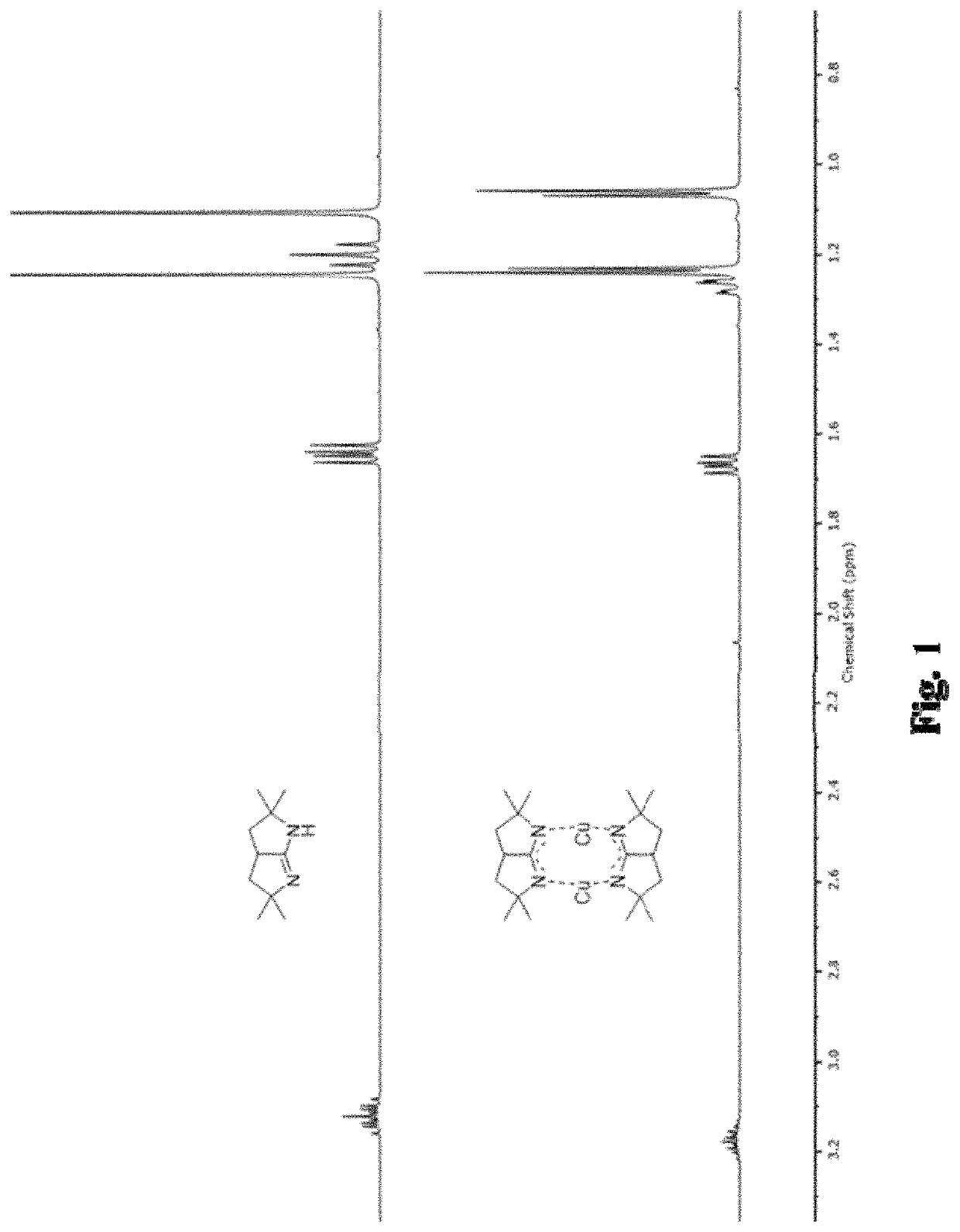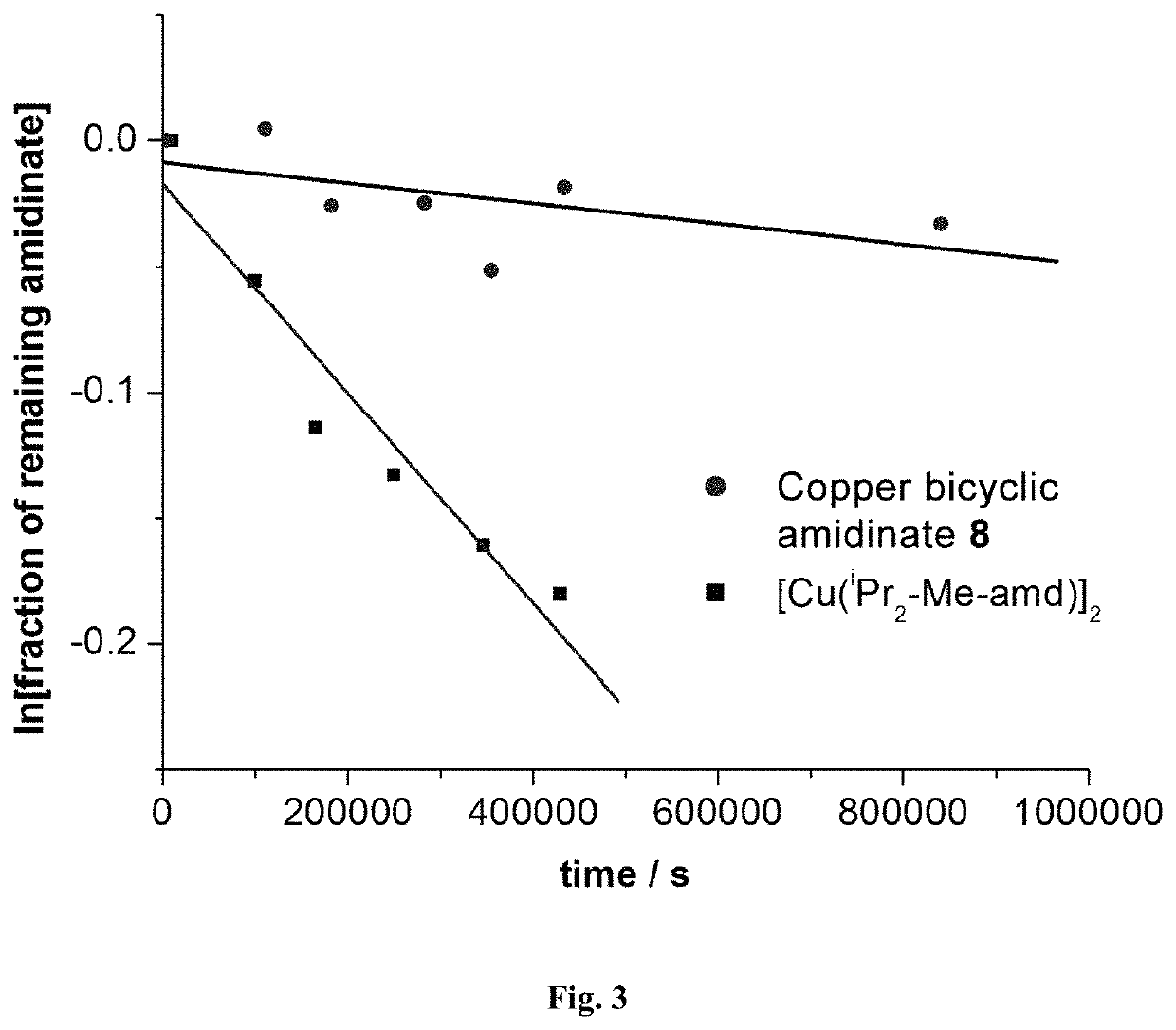Metal bicyclic amidinates
a technology of bicyclic amidine and amidinate, which is applied in the field of bicyclic amidine compounds, can solve the problems of difficult identification of compounds that meet all of these challenging requirements, poor step coverage of physical vapor deposition (pvd) techniques for depositing materials, and less than optimal thermal stability of alkoxides and dialkylamides, and achieves high electrical conductivity or other useful properties.
- Summary
- Abstract
- Description
- Claims
- Application Information
AI Technical Summary
Benefits of technology
Problems solved by technology
Method used
Image
Examples
example 1
of Tetramethyl 5,5-Bicyclic Amidine, 2,2,5,5-tetramethyl-1,2,3,3a,4,5-hexahydropyrrolo[2,3-b]pyrrole, compound 1a
[0149]
3-(2-amino-2-methylpropyl)-5,5-dimethylpyrrolidin-2-one 3a
[0150]DBU (29.53 g, 193.95 mmol) was dissolved in 500 ml of 2-nitropropane, followed by ethyl 2-(bromomethyl)acrylate 2 (18.72 g, 96.97 mmol). This was stirred at room temperature for 5 days, then concentrated under reduced pressure at 70° C. to give a large quantity of brown oil. This oil was taken up in 300 mL of Et2O and washed with 3.0M HCl (3×200 mL), brine (2×100 mL), then dried over MgSO4. Filtration and subsequent evaporation gave a blue-green oil that slowly solidified. This was dissolved in 1.5 L of EtOH, to which 20 g of MgSO4 was added, followed by 20 g of Raney Nickel that had been washed three times with 20 mL of iPrOH. The suspension was placed in a glass-lined Parr hydrogenator and pressurized with H2 to 150 psi, then mechanically stirred for 3 days at 50° C. After release of H2, the suspensio...
example 2
of Dimethyl 5,5-Bicyclic Amidine, 5,5-dimethyl-1,2,3,3a,4,5-hexahydropyrrolo[2,3-b]pyrrole, compound 1b
[0153]
[0154]3-(2-methyl-2-nitropropyl)dihydrofuran-2(3H)-one 5b. 5 mL of DBU was dissolved in 500 mL of 2-nitropropane, followed by 3-methylenedihydrofuran-2(3H)-one 4 (25.65 g, 261.47 mmol). This was stirred at room temperature for 2 days, then concentrated under reduced pressure at 70° C. to give a large quantity of brown oil. This oil was taken up in 250 mL of CH2Cl2 and washed with 3.0M HCl (2×250 mL), water (1×250 mL), saturated aqueous NaHCO3 (1×250 mL), brine (1×250 mL), then dried using anhydrous MgSO4. Filtration and subsequent evaporation gave 44.06 g (90%) of crude 5b as a pale brown solid, which was recrystallized from iPrOH to yield pure 5b (31.12 g, 64%) as white crystals, mp. 64-66° C. 1H NMR (500 MHz, CDCl3) δ 4.36-4.30 (m, 1H), 4.15-4.08 (m, 1H), 2.57-2.45 (m, 2H), 2.38-2.30 (m, 1H), 2.19-2.12 (m, 1H), 1.94-1.83 (m, 1H), 1.643 (s, 3H), 1.636 (s, 3H); 13C NMR (125 M...
example 3
of Unmethylated 5,5-Bicyclic Amidine, 1,2,3,3a,4,5-hexahydropyrrolo[2,3-b]pyrrole, compound 1c
[0163]
3-(2-bromoethyl)pyrrolidin-2-one 6c
[0164]5 mL of DBU was dissolved in 1 L of nitromethane, followed by 3-methylenedihydrofuran-2(3H)-one 4 (25.00 g, 254.84 mmol). This was stirred at room temperature for 1 day, then concentrated under reduced pressure at 50° C. to give a large quantity of brown oil. This oil was taken up in 250 mL of CH2Cl2 and washed with 3.0M HCl (2×250 mL), water (1×250 mL), saturated aqueous NaHCO3 (1×250 mL), brine (1×250 mL), then dried using anhydrous MgSO4. Filtration and subsequent evaporation gave 34.01 g of an amber oil (crude 5c) that was used without any further purification. 12.62 g (80.31 mmol) of this oil was stirred in 1.2 L of MeOH, together with 10 g of anhydrous MgSO4 and 9 g of Raney Nickel that had been rinsed with 10 mL of MeOH (3×10 mL). The suspension was placed in a glass-lined Parr hydrogenator and pressurized with H2 to 120 psi, then mechan...
PUM
| Property | Measurement | Unit |
|---|---|---|
| vaporization temperature | aaaaa | aaaaa |
| chemical shifts | aaaaa | aaaaa |
| chemical shifts | aaaaa | aaaaa |
Abstract
Description
Claims
Application Information
 Login to View More
Login to View More - R&D
- Intellectual Property
- Life Sciences
- Materials
- Tech Scout
- Unparalleled Data Quality
- Higher Quality Content
- 60% Fewer Hallucinations
Browse by: Latest US Patents, China's latest patents, Technical Efficacy Thesaurus, Application Domain, Technology Topic, Popular Technical Reports.
© 2025 PatSnap. All rights reserved.Legal|Privacy policy|Modern Slavery Act Transparency Statement|Sitemap|About US| Contact US: help@patsnap.com



